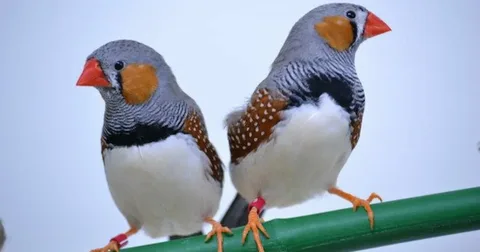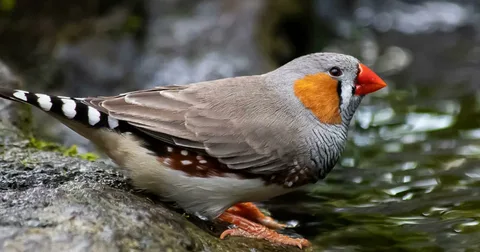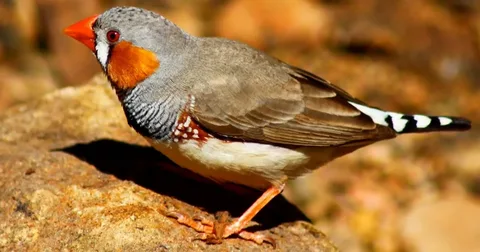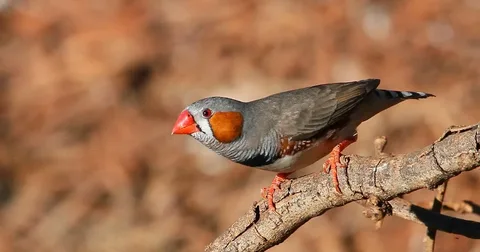The Fascinating World of Zebra Finches: Nature’s Melodic Charmers
1. Introduction to Zebra Finches

Zebra finches (Taeniopygia guttata) are small, energetic, and sociable birds that naturally inhabit arid and semi-arid regions of Australia, although they are also found in Indonesia, Timor-Leste, and other nearby islands. Their name comes from the distinctive black-and-white barring on their throats and upper chests, reminiscent of a zebra’s stripes.
2. Physical Appearance and Distinctive Traits

Despite their small size, zebra finches possess striking features that make them easy to identify. They typically measure about 4 inches (10 cm) in length and weigh around 12 grams, yet their vibrant colors leave a lasting impression.
- Males: Males are more visually striking, displaying bright orange cheek patches, a red or orange beak, and chestnut flanks dotted with white spots. The black tear-like stripe beneath their eyes and the fine zebra-like barring on their chest give them their distinctive look.
- Females: Females, though less colorful, have a soft elegance, featuring a light grey plumage with an orange beak and no cheek patches. Additionally, their lively eyes and energetic movements give them a playful, curious demeanor that endears them to bird lovers worldwide.
3. Habitat, Behavior, and Social Dynamics

Zebra finches are highly social birds, thriving in flocks where they engage in constant communication through chirps, whistles, and unique calls. In the wild, they are often found near water sources, open plains, and savanna grasslands, forming large colonies to enhance their survival.
Their behavioral adaptability is one of their most fascinating traits. Zebra finches display complex social hierarchies, with dominant males leading flocks and influencing mating decisions. Despite their small size, they are highly territorial during the breeding season, defending their nesting sites vigorously.
Communication plays a pivotal role in their social lives. Males are renowned for their melodious courtship songs, which are unique to each individual and often learned from their fathers. These songs not only attract mates but also help strengthen pair bonds. Research has shown that zebra finches have one of the most intricate vocal learning abilities among birds, making them a significant species for studying speech development and neural pathways.
4. Diet and Feeding Habits
Zebra finches primarily feed on grass seeds, which make up the bulk of their diet. Their short, sturdy beaks are perfectly designed to crack open small seeds effortlessly. In the wild, they forage on the ground, moving swiftly in flocks to search for food sources.
In addition to seeds, they also consume:
- Fresh greens like spinach, dandelion leaves, and lettuce
- Small insects during the breeding season, providing vital protein for chick development
- Fruits and vegetables in moderation when kept as pets
Their ability to adapt their diet based on availability is one of the key reasons for their survival in harsh, arid climates where food resources fluctuate seasonally.
When kept in captivity, zebra finches require a balanced diet consisting of quality seed mixes, supplemented with fresh greens, egg food, and calcium sources to maintain optimal health. Proper nutrition ensures vibrant plumage, stronger immunity, and better breeding success.
5. Breeding Behavior and Courtship Rituals

Males serenade females with distinctive songs while performing a playful “hopping dance” and offering small nesting materials as tokens of affection.
These birds prefer to nest in tree hollows, shrubs, or even man-made nesting boxes. They use grass, feathers, and twigs to build cozy, dome-shaped nests where females typically lay 4 to 6 small white eggs. Both parents share incubation duties, taking turns keeping the eggs warm for around 14 days.
Once the chicks hatch, both parents feed them regurgitated seeds and insects to ensure rapid growth. Within just three weeks, the fledglings are ready to leave the nest, displaying an impressive instinct for independence from an early age.
Their remarkable reproductive efficiency makes zebra finches highly successful survivors, even in challenging conditions where other species might struggle to maintain population numbers.
6. Zebra Finches in Research and Human Interaction
Beyond their popularity as pets, zebra finches have earned global recognition as a model species for scientific research. Their complex vocal learning, rapid breeding cycles, and well-understood genetics make them invaluable for studies in fields such as:
- Neurobiology – Understanding how the brain develops and processes learned behaviors
- Speech and Language Development – Exploring parallels between human language acquisition and bird vocal learning
- Behavioral Ecology – Examining how environmental factors influence social dynamics and reproduction
For bird enthusiasts, zebra finches make ideal companions due to their gentle temperament, playful energy, and soothing songs. However, providing proper care, space, and diet is essential to ensuring their well-being.
Conclusion
Zebra finches are tiny wonders of the avian world, admired for their striking plumage, cheerful songs, adaptive behaviors, and vital ecological roles. Whether thriving in the wild grasslands of Australia or living harmoniously alongside humans, they embody resilience, beauty, and intelligence in equal measure.
 Birds Drawing Birds Drawing
Birds Drawing Birds Drawing
